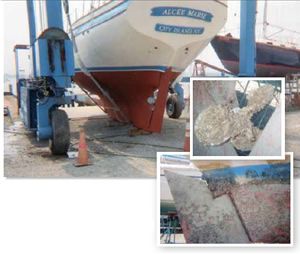
Photo courtesy of Jack Valdouw
300
Please see the photos of my Downeaster 38’s hull bottom and prop (at right) after the boat was in the waters off City Island (Bronx), N.Y., from June 6 until Aug. 25. The bottom paint used was West Marine Bottomshield; Pettit Zinc Coat Barnacle Barrier 1792 was used on the prop. As you can see, the treatments were pretty much failures. Barnacles grew over the bottom and clustered on the prop in just a few months.
After lightly sanding the previous season’s prop zinc treatment, I sprayed on three coats of new Barnacle Barrier. The previous season, I had applied the coating to bare metal and had much better results: Barnacles were fewer in number and much smaller in size. I do not see why one cannot apply Barnacle Barrier to a lightly sanded pre-existing zinc coating and get the same results as applying it to bare metal.
Regarding the use of the Bottomshield: In the 30 years I have had this boat, I have never had the growth of barnacles all over the bottom, usually barnacles on the waterline and slime on the rest of the hull bottom. Paints used in the past were Woolsey, Interlux VC, Pettit Trinidad, Pettit Trinidad SR, and more recently Pettit Unepoxy. My results make the use of Bottomshield and Barnacle Barrier very questionable for this area.
Jack Valdouw
Alcee Marie, Downeaster 38
City Island, N.Y.
While the Pettit-made West Marine Bottomshield (pre-2010) earned Recommended ratings in some past PS antifouling tests—even after 24 months (PS, October 2011)—test panels coated with the more recent formulations have not fared as well. Like many manufacturers, Pettit has reduced the copper content in some of its paints. Previous versions of the single-season Bottomshield were 46-percent copper, but the newer iterations contain only 29 percent. In the most recent report (PS, March 2012), it rated Fair after 14 months in Florida, meaning it was still repelling hard growth.
We also have seen year-to-year variability among antifouling paints of identical formulas (although not as significant as yours) in our tests. Pettit has several other paints that have done consistently well over the years. The copper-heavy Pettit Trinidad (76 percent) and Trinidad SR (70 percent) have proven more effective in recent panel tests, earning Good ratings after 14 months and Recommended ratings after 30 months. We suggest going with one of those, especially if they historically have done well for you.
Regarding the Barnacle Barrier: We’ve not yet field-tested it, but we’ve had good reports from readers who use it. According to their reports, applying it to bare metal—as the directions call for—allows for better adhesion and, therefore, better results.
In the excellent comparison of marine epoxies in the June 2012 issue, one crucial aspect was left out of the evaluation: measuring out the ratio of resin to hardener. Get that wrong, and the whole project could fall apart, literally.
I have been using West System for about five years with excellent results; the mini-pumps make measuring a no-brainer, and the West System support system also is terrific.
The Interlux Epiglass looks interesting, but no mention was made of how to measure the proper ratio. Is it easier than the West System pumps?
Dwain Lovett
Mystique, Spirit 28
Montserrat, West Indies
The Interlux Epiglass pumps, just like the West System pumps, are calibrated for super easy mixing. With both brands, one pump dispenses the exact amount needed to get the right mixing ratio of resin and hardener, so their ease of application is pretty much equal. When using any maker’s pumps, remember that they are not infallible. Pumps have a tendency to suck air as the container volume lowers or when the prime is lost between uses. A better way to ensure mixing ratio accuracy is to use measuring cups and to mix based on the designated weight ratios of hardener and resin.
Have you reviewed any apps that allow you to keep track of “buddies” on the water if they have AIS? We have a club that rafts up often, and it can be good to keep track of vessels that haven’t arrived yet when the weather is a bit iffy. We currently use Google’s Latitude App, but would be interested to know of any better ones out there.
Joel Rutzen
We have not yet tested those types of apps, but we’d like to hear from readers who have. Email practicalsailor@belvoirpubs.com.
I just wanted to let you know that the Miracle Cloth, PS’s Best Choice Metal Polish (PS, March 2007 and February 2009), is available from a source other than West Marine. We’ve been buying it (and loving it) from West for years, but we’ve had problems finding it lately.
It’s actually made by CAA Enterprises (www.caaenterprises.com). They sell direct, and if you buy 12, they are less than $3 each! That’s versus $13 or $14 each from West Marine. (Just one is $6, delivered.) We have tested products from both places, side-by-side, and they appear identical.
Bill Streep
Merlin, Macintosh 47
Port Aransas, Texas
The Sta-bil ethanol fuel treatment featured in our August 2012 issue was the marine formula, which is different from the standard formula sold in many hardware stores.

































